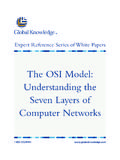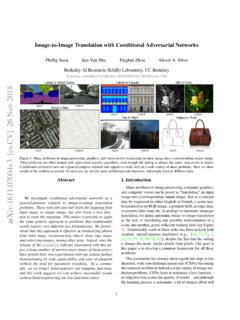Transcription of Computer Networks
1 1 Computer Networks A group of two or more Computer systems linked together. There are many [types] of Computer Networks : Peer To Peer (workgroups) The computers are connected by a network , however, there is NOT a Server present. Client/Server The computers are connected by a network , and there is a Server present. Other Classifications: Local-area Networks (LANs): The computers are geographically close together (that is, in the same building). Metropolitan-area Networks (MANs): The computers are farther apart and are connected (that is, in the same city). Wide-area Networks (WANs): The computers are farther apart and are connected (that is, NOT in the same city). In addition to these types, the following [characteristics] are also used to categorize different types of Networks : Topology : The geometric arrangement of a Computer system.
2 Common topologies include a bus, star, and ring. Hybrids of these are, star bus & star ring. Protocol : The protocol defines a common set of rules and signals that computers on the network use to communicate. Architecture : Networks can be broadly classified as using either a peer-to-peer or client/server architecture. One of the most popular architecture for LANs is called Ethernet. Another popular LAN architecture for PCs is the IBM token-ring network . Computers on a network are sometimes called nodes or workstations. Computers and devices that allocate resources for a network are called servers or file servers. Internetworking The art and science of connecting individual local-area Networks (LANs) to create wide-area Networks (WANs) , and connecting WANs to form even larger WANs. Internetworking can be extremely complex because it generally involves connecting Networks that use different protocols.
3 Internetworking is accomplished with routers, bridges, and gateways. Routing In internetworking, the process of moving a packet of data from source to destination. Routing is usually performed by a dedicated device called a router. Routing is a key feature of the Internet because it enables messages to pass from one Computer to another and eventually reach the target machine. Each intermediary Computer performs routing by passing along the message to the next Computer . Part of this process involves analyzing a routing table to determine the best path. Routing is often confused with bridging, which performs a similar function. The principal difference between the two is that bridging occurs at a lower level and is therefore more of a hardware function whereas routing occurs at a higher level where the software component is more important.
4 And because 2routing occurs at a higher level, it can perform more complex analysis to determine the optimal path for the packet. Local-Area network -LAN A Computer network that spans a relatively small area. Most LANs are confined to a single building or group of buildings. However, one LAN can be connected to other LANs over any distance via telephone lines and radio waves. A system of LANs connected in this way is called a wide-area network (WAN). Most LANs connect workstations and personal computers. Each node (individual Computer ) in a LAN has its own CPU with which it executes programs, but it is also able to access data and devices anywhere on the LAN. This means that many users can share expensive devices, such as laser printers, as well as data. Users can also use the LAN to communicate with each other, by sending e-mail or engaging in chat sessions.
5 There are many different types of LANs, Ethernet being the most common for PCs. Most Apple Macintosh Networks are based on Apple's AppleTalk network system, which is built into Macintosh computers. The following characteristics differentiate one LAN from another: Topology : The geometric arrangement of devices on the network . For example, devices can be arranged in a ring or in a straight line. Protocols : The rules and encoding specifications for sending data. The protocols also determine whether the network uses a peer-to-peer or client/server architecture. Media : Devices can be connected by twisted-pair wire, coaxial cables, or fiber optic cables. Some Networks do without connecting media altogether, communicating instead via radio waves. LANs are capable of transmitting data at very fast rates, much faster than data can be transmitted over a telephone line; but the distances are limited, and there is also a limit on the number of computers that can be attached to a single LAN.
6 Metropolitan Area network - MAN Short for Metropolitan Area network , a data network designed for a town or city. In terms of geographic breadth, MANs are larger than local-area Networks (LANs), but smaller than wide-area Networks (WANs). MANs are usually characterized by very high-speed connections using fiber optical cable or other digital media. Wide-Area network - WAN A Computer network that spans a relatively large geographical area. Typically, a WAN consists of two or more local-area Networks (LANs). Computers connected to a wide-area network are often connected through public Networks , such as the telephone system. They can also be connected through leased lines or satellites. The largest WAN in existence is the Internet. Topology The shape of a local-area network (LAN) or other communications system. There are three principal 3topologies used in LANs.
7 Bus topology: All devices are connected to a central cable, called the bus or backbone. Bus Networks are relatively inexpensive and easy to install for small Networks . Ethernet systems use a bus topology. Ring topology : All devices are connected to one another in the shape of a closed loop, so that each device is connected directly to two other devices, one on either side of it. Ring topologies are relatively expensive and difficult to install, but they offer high bandwidth and can span large distances. Star topology: All devices are connected to a central hub. Star Networks are relatively easy to install and manage, but bottlenecks can occur because all data must pass through the hub. These topologies can also be mixed. For example, a bus-star network consists of a high-bandwidth bus, called the backbone, which connects a collection of slower-bandwidth star segments.
8 Protocol An agreed-upon format for transmitting data between two devices. The protocol determines the following: the type of error checking to be used data compression method, if any how the sending device will indicate that it has finished sending a message how the receiving device will indicate that it has received a message. There are a variety of standard protocols from which programmers can choose. Each has particular advantages and disadvantages; for example, some are simpler than others, some are more reliable, and some are faster. From a user's point of view, the only interesting aspect about protocols is that your Computer or device must support the right ones if you want to communicate with other computers. The protocol can be implemented either in hardware or in software. Architecture A design. The term architecture can refer to either hardware or software, or to a combination of hardware and software.
9 The architecture of a system always defines its broad outlines, and may define precise mechanisms as well. An open architecture allows the system to be connected easily to devices and programs made by other manufacturers. Open architectures use off-the-shelf components and conform to approved standards. A system with a closed architecture, on the other hand, is one whose design is proprietary, making it difficult to connect the system to other systems. Media In Computer Networks , media refers to the cables linking workstations together. There are many different types of transmission media, the most popular being twisted-pair wire (normal electrical wire), coaxial cable (the type of cable used for cable television), and fiber optic cable (cables made out of glass). Segmentation 4 The act of improving network performance by dividing a single large network into multiple smaller, less congested LANs while maintaining connectivity between them.
10 Switches offer an effective segmentation tool by providing each port with dedicated bandwidth without requiring users to change any existing equipment such as NICs, hubs, wiring, or any routers or bridges that are currently in place. Switches can also support numerous transmissions simultaneously. Segment In Networks , a section of a network that is bounded by bridges, routers, hubs, or switches. Dividing an Ethernet into multiple segments is one of the most common ways of increasing bandwidth on the LAN. If segmented correctly, most network traffic will remain within a single segment, enjoying the full 10 Mbps bandwidth. Hubs and switches are used to connect each segment to the rest of the LAN. See under polyline. Polyline In Computer graphics, a continuous line composed of one or more line segments. You can create a polyline by specifying the endpoints of each segment.








![ABSTRACT arXiv:1409.1556v6 [cs.CV] 10 Apr 2015](/cache/preview/4/e/0/e/4/4/2/c/thumb-4e0e442c20fc4f8e108fa20a1095af07.jpg)

